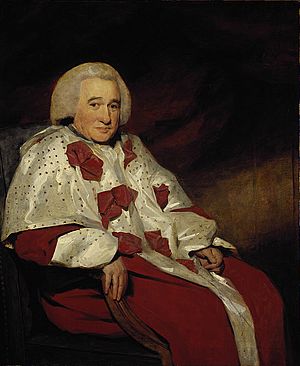Robert McQueen, Lord Braxfield facts for kids
Quick facts for kids
Lord Braxfield
|
|
|---|---|

Lord Braxfield
|
|
| Lord Justice Clerk | |
| In office 13 December 1776 – 30 May 1799 |
|
| Personal details | |
| Born | 4 May 1722 Lanark |
| Died | 30 May 1799 (aged 77) George Square, Edinburgh |
| Spouses | Mary Agnew; Elizabeth Ord |
| Alma mater | University of Edinburgh |
| Profession | Advocate |
Robert McQueen, Lord Braxfield (born May 4, 1722 – died May 30, 1799) was an important Scottish lawyer and judge. He became well-known for his strict approach in court.
Contents
Early Life and Career
Robert McQueen was born at Braxfield House, near the town of Lanark, on May 4, 1722. His father was John McQueen.
Becoming a Lawyer
He studied law at Edinburgh University. In 1744, he became an advocate, which is a type of lawyer who speaks in higher courts. By 1759, he was appointed an Advocate Depute. This meant he represented the Crown (the government) in court cases. He was very busy, sometimes handling more than 15 cases in a single day! He earned a lot of money for his work.
Rise to Judge
In 1776, Robert McQueen became a judge. When he became a judge, he took the special title of Lord Braxfield.
Lord Justice Clerk
By 1788, he rose to become the Lord Justice Clerk. This was the second most important judge in all of Scotland. Lord Braxfield believed that the government should mainly represent the interests of landowners. He played a big role in stopping groups like the Friends of the People Society. These groups wanted to change how the country was run. Lord Braxfield was known for being very tough on people who challenged the government. He famously said, "Let them bring me prisoners, and I will find them law," which showed his strong and determined approach to justice.
He also oversaw a very unusual trial in 1795. This was the case of Sir Archibald Gordon Kinloch of Gilmerton, who was accused of killing his half-brother.
Later Years and Legacy
Lord Braxfield passed away at his home in George Square, Edinburgh, on May 30, 1799. He was 77 years old. He was buried in his family's burial place in Lanark. After he died, his wife moved to a new home in Princes Street.
Braxfield House, where he was born, later became the home of Robert Owen. Owen was a famous social reformer who built the nearby community of New Lanark.
Family Life
Lord Braxfield was married twice.
First Marriage
His first wife was Mary Agnew. She was the daughter of Major James Agnew. Robert and Mary had four children together:
- Robert Dundas
- John, who became a captain in the army
- Mary, who married Sir William Honyman, Lord Armadale in 1777
- Katherine, who married John Macdonald, the chief of Clanranald, in 1786
Second Marriage
Lord Braxfield's second wife was Elizabeth Ord. She was the daughter of Robert Ord, who was a very important judge in Scotland's financial court. Robert and Elizabeth did not have any children together.
Influence and Reputation
Lord Braxfield was a memorable figure in Scottish history.
Famous Portrait
The famous artist Sir Henry Raeburn painted a portrait of Lord Braxfield not long before he died.
Strict Judge
Lord Braxfield is well-known in Scotland for how strictly he dealt with people in court. He was famous for his direct and sometimes harsh way of speaking. For example, he once told a defendant, "Ye're a vera clever chiel, man, but ye wad be nane the waur o' a hanging." This means, "You're a very clever fellow, but you wouldn't be any worse off for a hanging." This shows his tough style. Some historians see him as a very controversial figure in Scotland's past.
In Literature and Places
He is believed to be the inspiration for the judge character in the unfinished novel Weir of Hermiston by the famous author Robert Louis Stevenson.
A street in New Lanark called Braxfield Row is named after his family's estate.
Lord Braxfield also served as a Trustee for the University of Edinburgh and helped with the building of the South Bridge in Edinburgh.

